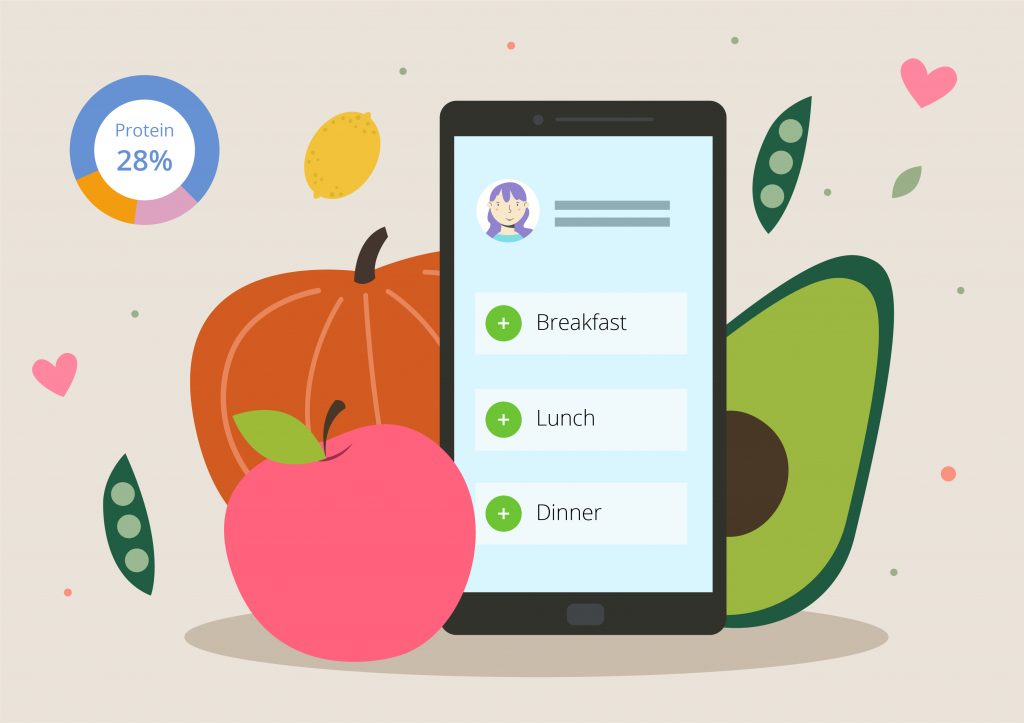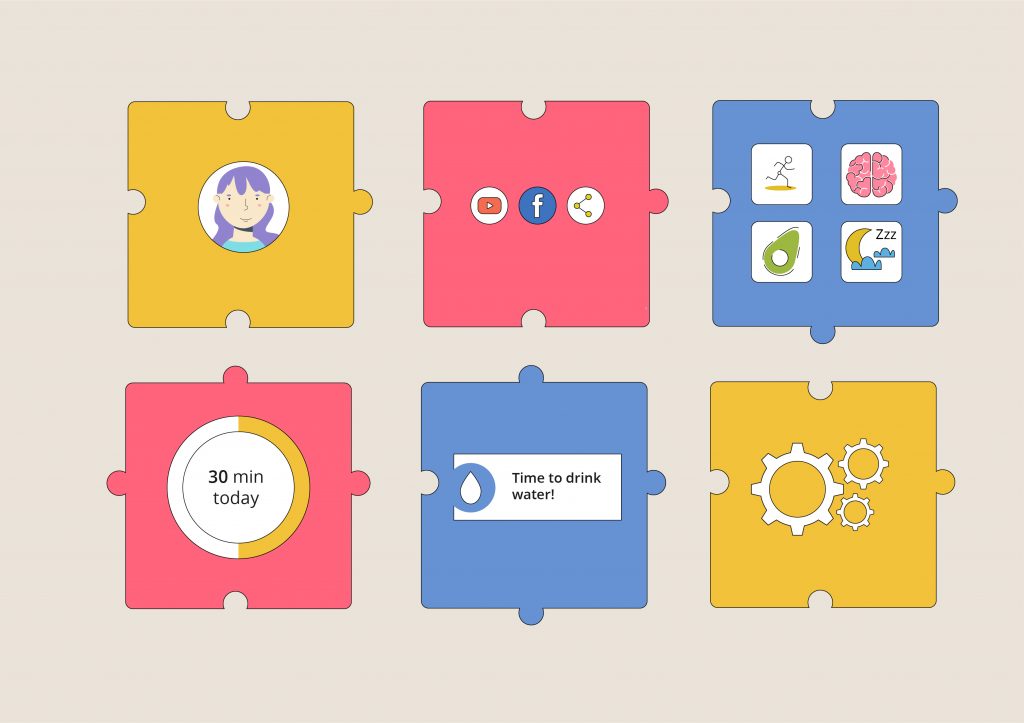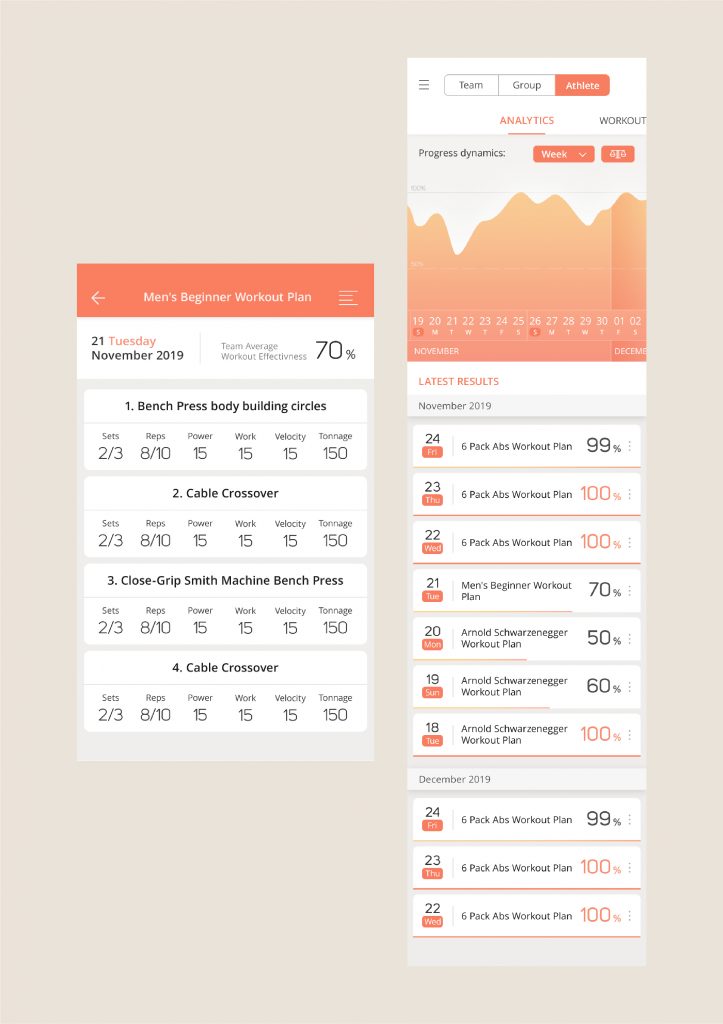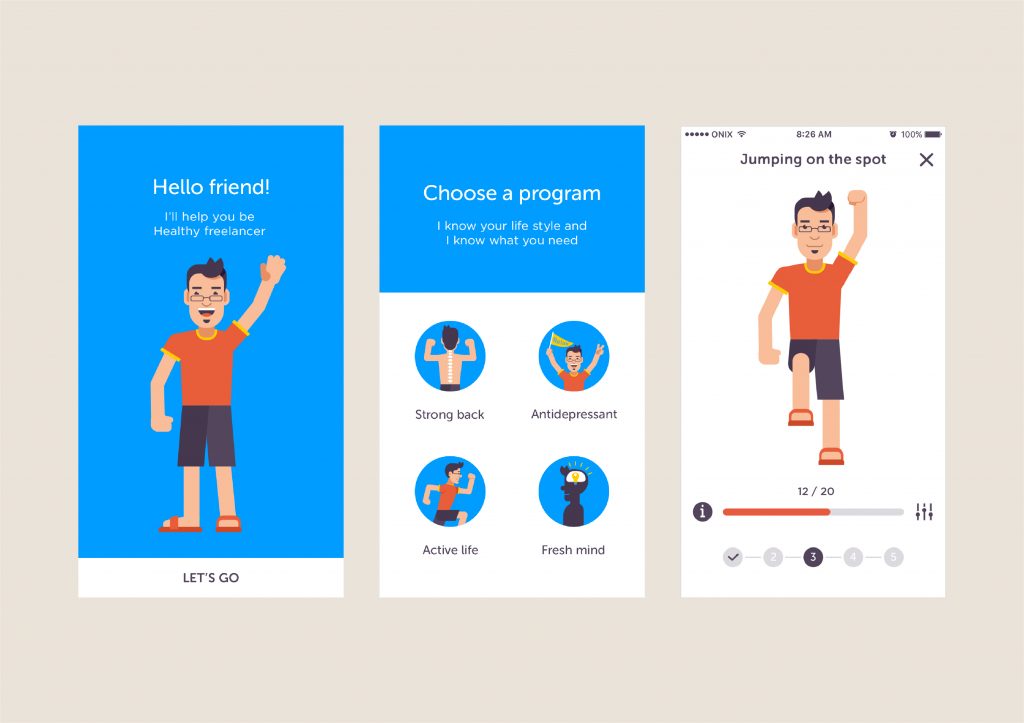How to Create a Fitness App and Generate Revenue with It

While people may be spending over 3 hours a day with their favorite mobile applications, it would be wrong to assume that they are only listening to music, chatting and shopping online, or following other peoples’ glamorous lives. More and more people realize that a sedentary lifestyle combined with fast food consumption can lead to health problems. They are increasingly interested in exercising, proper nutrition, and staying healthy while maintaining their lifestyle and busy schedules.
Luckily, innovations in smartphones, tablets, and wearables have made blood pressure, heart rate, or step calculation easy and available at users’ fingertips. A mobile fitness app on the smartphone can act as a dietician in their pocket or a personal coach to guide and track their exercise activities wherever the user wants. These apps can help maintain their routines and achieve health goals.
It’s a great time for entrepreneurs to create a fitness app. The growing adoption of smartwatches, smart bands, smart rings, and other wearable devices are leading to the expansion of the global fitness app market. According to a study published by Polaris Market Research, this market was valued at USD 3.15 billion in 2019. Smartphones prevailed due to increasing affordability and penetration in emerging economies, and the women’s segment dominated the global fitness app industry. The market is anticipated to grow at a compound annual growth rate (CAGR) of 26.2% by 2026.
According to the Fitness App Market Research Report – Global Forecast 2023, the market is expected to be growing at 23% CAGR through the forecast period.

Whatever the numbers, vendors that invest in fitness apps have a great chance to increase their market share and profitability. Adidas acquired Runtastic, Under Armour invested in MyFitnessPal, and more mergers and acquisitions are happening. Building these sorts of products can be a brilliant startup idea.
In this article, you can find valuable tips on how to create a fitness app and ideas for generating revenue with it.
Six Steps to Create a Fitness App
A fitness app developer will follow the same steps as with any mobile application:
- Market research and concept development
- Selection of features and requirements documentation
- App revenue model
- User experience and user interface (UX & UI) design
- Mobile frontend and backend development and quality assurance
- App launch, evaluation, and improvement
Let’s see what specifically should be considered during a fitness mobile app development.
1. Research and ideation
The market is currently segmented into six categories.

Image source
According to the Global Fitness App Market research report 2020, the lifestyle monitoring segment should continue its steady growth trend as illustrated above. The rising popularity of workout and diet/nutrition apps will play a significant role in this segment to maintain its market position. In this article, we’ll concentrate on these three types:
Workout and exercise apps
These apps typically provide the following:
- Various exercise programs and guidance for workouts. For example, there may be Core Strength, Yoga, Full Body, Upper Body, Lower Body, exercises for a particular body part, or targeting specific pain points. The content may include videos, audio instructions, and textual descriptions; video tutorials are arguably the most effective. If you opt for audio guidance, it still makes sense to include textual instructions too.
- The app may enable users to create and modify a personal workout routine as well, using a pool of pre-defined exercises and the option to create their own.
- Timer and the ability to set the duration of exercises, pause and skip them, and switch to silent mode from the workout screen
Fitness & activity tracking apps
These apps track user activity data from mobile devices’ sensors or connected wearables. They monitor nearly everything a user does: the number of steps walked, stairs climbed, distance run and speed, heart rate, calories burned, hours slept, etc. They display the info on a user device screen, can build charts, demonstrate user progress, and issue movement reminders. There may also be functionality for storing and managing body measurements/weight history, favorite types of activity/sports, exercise duration, and other information.
Diet & nutrition apps
These apps help users stick to a diet, lose or gain weight, shift to healthy eating, and so on. They can monitor user nutrition habits, count consumed and burned calories, track body weight, help control water balance and coffee intake, and so forth.
A diet tracker mobile app may include:
- A considerable database of foods, with the ability to create grocery lists or save favorite foods and meals
- Calculation of a user’s target number of calories based on their age, gender, and weight
- Calorie counter or food diary to help track the diet
- Ability to set personal goals
- Communication features, such as a forum for sharing users’ experiences, recipes, etc.
- Detailed and comprehensive daily stats
- Suggestions on what to eat based on the user’s exercise level, and so on

Within each type, fitness apps can be developed for different population groups and levels of fitness. For instance, there are products for children or pregnant women. You may also design an app for a particular goal, such as preparation for a marathon or recovery after injury. When Alternative-spaces was building the LiftSync mobile app, which targeted university, college, and school teams instead of an individual athlete, there was no equivalent on the market.
Develop your unique value proposition, research your prospects with Apple vs. Android users, and study the target audience to learn how to better meet their needs. For instance, while designing Happy Freelancer, our team had to investigate freelancers’ daily health concerns: eye strain, pain in the back and wrists, gaining weight, lack of energy, etc.
It’s useful to study the industry leaders and your niche rivals regarding the most valuable features and UX/UI design. Currently, the main players in the global fitness app market include Appster, ASICS, Azumio, Dom, Fitbit, Grandapps, Motorola Mobility LLC, MyFitnessPal Inc., Nike, TomTom, Under Armour, and WillowTree, Inc., among others. The research will also supply ideas on how to monetize an app of your type.
2. The features of your fitness app
The app’s features fall into three groups:
- Essential/must-have fitness features
- Desired features, mainly depending on the specific app type
- Features that may give your product a competitive advantage
Generally, all fitness apps should include:
- User profile. Users should be able to switch between devices to access your app’s services and content and track their goals and achievements. The personal account may contain information about their age, weight, height, goals, preferences, etc. This info may also help your app to offer the most relevant workout routines, diet plans, or other services and even goods to the user.
- Social media integration. The integration of several social networks not only helps users to register and log in faster, but also promotes social sharing, e.g., posting advice and achievements on Facebook. App users may also invite and challenge their friends, increasing customer engagement and spreading the word about your brand.
- Functionalities for activity monitoring. The app may be monitoring physical or other user activities, e.g., sleep patterns. For exercise and activity tracking apps, integration with the mobile device’s sensors and wearables are essential for accurate data recording and progress tracking. Apple’s HealthKit and Google Fit API facilitate access to the health and fitness data collected on the iOS and Android platforms, respectively. It is advisable to cooperate with as many wearable producers as possible. Geolocation and mapping are required to count kilometers/distance user runs, walks, or cycles, as well as to visualize covered/training routes.
- Results and progress tracking. Whether your app tracks kilometers run, exercises completed, calories burned, or any other parameters, all statistics must be easily accessible in an understandable format. For example, LiftSync accompanied by fitness wristbands allowed comparing the progress of a whole team, individual members, and groups within a team. The results could be analyzed by weeks, months, years, or within a custom time range.
- Push notifications and pop-ups. An app can send reminders of scheduled workouts or other notifications (“It’s time to drink some water”) to keep users organized and continuously push them towards their goals. It can also display information or motivating pop-ups, e.g., “You have done better than 80% of our app users!” Notifications and pop-ups can act as a gamification element and thus a great driving force for your app. They are extremely engaging, as the activity rings on Apple Watch have proven. A user is given extra time to achieve goals if they perform mini-tasks promoted by reminders, such as periodic warm-ups, breathing exercises, physical exercise at unusual times, etc. “You can still achieve the daily goal by the end of the day” and other motivating messages will not allow users to give up either their fitness habits or your app.
- Application settings. Besides reading your app’s Terms and Conditions, users can define units, select the language, manage privacy settings, and more.

The desired features, besides the ones listed for the different fitness app types, may include:
- Educational content on fitness, health, nutrition, etc.
- Built-in messaging functionality for app users
- User-engaging or gamification elements, e.g., earning points, scoreboards, virtual races against friends, or slimming competitions with app users across the country
Unique social features, gamification, live video streaming, or even dating functionality may help your mobile fitness app stand out from the crowd. For example, people love sharing their triumphs with the world. Your app may become a new Instagram or TikTok with ‘star’ users and hordes of dedicated followers. New vegans might appreciate the ability to order recommended foods right from the app. Kids may be motivated to run on treasure quests, chasing cute animals, or competing against characters supplied by augmented reality.
When you prioritize app features, consider any timeframe or budget limitations as well. For example, building a gym fitness app would be more challenging due to the necessity to integrate with wearables and devices at the gym. Pre-recorded video tutorials may imply costly cooperation with outside professionals. Compared to other content formats, they would consume more resources during content preparation, infrastructure building, testing, and subsequent content management.
The technical documentation should describe all selected features. Product technical specifications include use cases, platforms, and all other information required by app developers. The defined scope of work will help you develop the project roadmap, plan resources, and secure budget. Plan and start content development as early as possible. After thorough research, you are going to acquire tons of textual, audio, or video content, quality copy (possibly in several languages), photography, and so forth.
Once you have figured out the product’s purpose, contents, and working principle, it’s time to think about monetizing your mobile app.
3. Selection of the monetization method
If you are developing a mobile fitness app as a supplement or bonus to increase the value of sports equipment, clothing, shoes, nutrition, or membership in a gym chain, it’s perfectly fine to offer the app for free and forget any monetization efforts. If you are willing to make a profit with it, multiple options are available.
Ads-based model.
People may be spending hours on their phones every day, but few also want to spend their money on top of that. In-app advertising seems like a lesser evil to them, but it may be good when relevant goods or services are promoted, complementing your app users’ experiences. The better the user experience, the higher the engagement and your revenue.
Mobile app advertising comes in five shapes: native, short videos, and incentivized ads, and the least successful interstitial and banner ads. The three most popular business models for mobile ads are effective Cost Per Mille (eCPM), Cost-Per-Click (CPC), and Cost-Per-Action (CPA). CPC model rewards the app publisher only when a user taps on a mobile app ad. CPA requires that users that saw an ad should proceed to act: download an advertised mobile app, subscribe to an advertised service, etc. eCPM is the most lucrative model because it does not depend on whether users are actually interacting with an ad. (You can learn about more models, as well as mobile ad types and advertising networks here.) It goes without saying that a large user base is vital.
Along with receiving these commission fees, app publishers can benefit from lead generation. Mobile apps can capture the contact information of app users that are interested in specific services or products. Sports clothing manufacturers or other interested companies can reward app owners for supplying this information.
In-app purchases.
Many types of in-app purchases are possible within a fitness app: more workouts, celebrities’ tutorials, healthy diet recipes, additional app functionalities, and more. Users might also choose among several plans with options to upgrade or downgrade. For example, auto-renewable subscriptions give access to periodically updated premium app content or features for a fixed period. The subscription would regularly renew automatically until manually canceled by the user. That way, they will not forget to pay for the desired content and features. The most profitable model is to offer separate subscription options and one premium package combining all the services.
You can also enable app users to purchase physical items, e.g., sports equipment or foods, directly from the app. Health/fitness services providers can integrate in-app billing.
Freemium model.
This model allows consumers to ‘try before you buy.’ They download a free version of the app with a limited set of basic features. If they like it and want more, e.g., advanced fitness plans, more features, or remove ads, they should pay for the premium feature set. It’s a matter of making a careful choice for what app features to provide free of charge and which ones to put into the paid set. The minimum free features should give users a taste of what your app can do, and premium features should complete the experience that is worth their money.
Sponsors and partnerships.
This business model implies partnering with sports brands, gyms, experts, celebrities, and others. For example, fitness instructors and influencers can create valuable content and distribute it through your fitness app. If your partners endorse your app, there’s a solid chance their followers might download it.
Sometimes, a relevant company acts as a single advertiser offering products or services to the app users. Such a sponsor can be presented with its logo and other branding elements integrated into the app’s design, via a splash screen, push notifications, and other ways. Partnership with a big brand is a winning card in monetizing your mobile app, especially if you manage to forge an integrated app experience.
Paid downloads.
Before using your app, users might pay to install it. The price depends on the application type, mobile platform, and the app’s content. However, currently, this model does not seem to be popular among fitness app publishers: for example, the best workout apps out there are either free, or subscription-based, or freemium apps.
These are only a few possible ways of monetizing your mobile app. Be creative and search for opportunities that may be unique to your product. For example, imagine your app enables users to design their own workout routines, nutrition plans, or healthy eating challenges. You can arrange for the user-created content to be shareable to other users within the app for free or for a fee. If an app user earns money this way, your app will charge a percentage.
4. UX and UI design.
The market analysis and documented project requirements provide the basis for UX/UI designers to develop the user flow map, clickable prototype, and the visual design of your mobile app.
Your solution to the end-users’ problem should be neither too complicated nor too simple. The app’s structure should be straightforward, navigation intuitive, the textual content and controls minimized, and the interface should be clean but motivating. Each control should be easily accessible on devices with different screen sizes so that users could navigate through the app at the reach of one thumb while exercising. Let exercises in a workout routine switch automatically, but enable swiping too.

Depending on the target audience’s needs, you may either opt for minimalism or emotional design with flashy colors, images, and animations. Regardless, users should be able to perceive information easily and complete the tasks quickly. Use color coding and select the typography to reduce the time needed to process information.

5. Mobile app development
To turn your ideas into a working solution, you will need at least two app developers: either an iOS or Android mobile app developer plus a backend developer. If you are developing your product for both platforms, you will need three developers. There will also be a project manager and quality assurance (QA) staff.
Several factors are important when selecting your fitness app developers:
- the developers’ expertise and years of experience
- experience in developing similar apps
- their hourly rates, which can vary dramatically depending on the geographical location
- the team’s cooperation practices and project management tools in place
Quality assurance takes up to 1/3 of the development time. Besides checking the code for bugs, QA engineers test whether all the features work correctly and evaluate the overall user experience.
6. App launch, evaluation, and improvement
Once your app is up and running, you can start monitoring the user base, set the key performance indicators, monitor the results, analyze the app performance, garner user feedback, and more. All of this information will help you understand whether the chosen app structure and monetization method are working the way you expected and make appropriate adjustments.
You will also have to regularly update your app. Always make sure there’s something irresistible that can keep your most consistent customers coming back for more. They should never feel like they’ve already used the app to its full potential. For example, a constant stream of new original content can convert new users into lifelong paying customers. Develop the features to entice most enthusiastic users to spend as much money as necessary to advance in-app.
Summing Up
Physical fitness, health, and lifestyle awareness is a major trend, and mobile applications which deliver fitness- and health-related services to users are commonplace. Fitness apps may help users to lose weight, embrace healthy habits, reach individual nutrition goals, maintain a better physical and emotional health, and more.

The basic features for a fitness app are a personal account, typically a set of predefined exercises, workouts, diet plans, etc., features for setting goals and actual activity tracking, notifications, and social sharing. Mobile ads, subscriptions, or the freemium model can be selected or combined for generating revenue through your app. It is particularly beneficial to partner with relevant sponsors and run fitness-oriented advertising campaigns.
Increasing consumer awareness combined with technology advances and growing demand from emerging economies shall provide numerous growth opportunities to the global industry of fitness applications in the coming years. According to Statista, the number of fitness app users is expected to reach 987 million by 2024. While there are many competitor apps aimed at different aspects of everyday life, this niche remains prospective. All these factors make this year a perfect time to build your own workout app, diet tracker, or related type of app and claim your share of the pie.
An average timeline for building a fitness app starts from approximately 4 months. The amount of effort and time required primarily depends on the app type, number of features required, type and amount of content, and the targeted platform(s). In any case, we recommend starting with a mobile app MVP (Minimum Viable Product). This approach helps to save money and test out the idea without spending too much effort and resources. And remember that Alternative-spaces is here to help make the most of your ideas.
Content created by our partner, Onix-systems.
 Home
Home